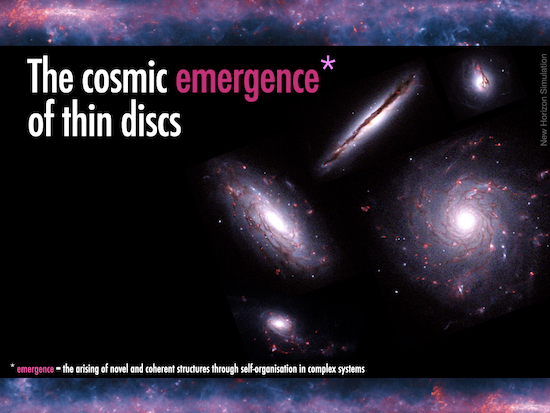Secular PhD 2023
Disc settling as an emergent process
Astrophysical context
Most stars are born in stellar disks. Major mergers destroy some of these disks recurrently in the history of the Universe, but some have survived until today, including our own Milky Way. Understanding the long-term survival of these stellar disks is therefore an essential ingredient of modern cosmology. The stabilization of the thickness of disks (thin and thick) in our Galaxy is also a dynamical problem that has recently been revived in the light of recent astrometric surveys. Star formation generally occurs on the circular (non intersecting) orbits of the gas, so young stars typically form a very thin disk. However, chemo-dynamic observations of old Milky Way stars have all shown that thick disks are also very common. The simultaneous formation of thin and thick stellar disks (S0 and Sc galaxies) is therefore an important puzzle for the theory of galaxy formation
Various dynamic mechanisms, internal or external, have been proposed to explain the observed thickening or rejuvenation, but their respective impacts and roles remain to be quantified. Some major violent events contribute to the extended vertical distribution of stars in disks: accretion of galactic satellites, major mergers of gas-rich systems, or even gravitational instabilities in massive turbulent disks. Violent mergers certainly have a strong impact on galactic structure, but the thickening of stellar disks could also result from the slow and continuous heating of pre-existing thin disks, through multiple minor mergers or internal secular processes. The induced density waves may also increase their dispersion in velocity, which can be converted into vertical motion via deflections on giant molecular clouds. The corresponding radial migration will also play an important role in their secular evolution.
The epoch of cosmic environment settling allows secular resonant processes to take over to define the morphology of galaxies (bar formation, radial migration, disk heating and thickening, etc.). These discs are cold and therefore fragile dynamical systems for which rotation provides an important reservoir of free energy, and where orbital resonances play a key role. The availability of this free energy leads to a strong amplification of certain stimuli, with the net result that even a small disturbance can in principle lead to disks evolving towards substantially distinct quasi-equilibria. These disks are furthermore immersed in various sources of perturbations, ranging from fluctuations coming from the cosmic environment, stochastic cosmic infall, shot noise coming from the finite number and short life span of giant molecular clouds in the interstellar medium, to globular clusters and substructures in orbit around the galaxy. Spiral arms and central bars provide other sources of coherent stimulation. The cosmic history of galactic disks must therefore include the common responses to all these various stimuli (internal and external).

Upshot
This PhD will be focused on studying the cosmic appearance of thin galactic disks as an emerging process induced by self-regulation between cooling mechanisms (e.g. coplanar infall of gas), and heating processes (merging of small virialised objects, turbulence, deflection on molecular clouds etc). We will aim to show that cosmic evolution conspire to promote a redshift-dependant transition mass between cosmic-driven morphology on the one hand (through mergers, strong feedback and turbulence), to secularly- driven morphology on the other hand (which promotes self-regulation around an effective Toomre Q number close to one). Through this process, a novel and fragile but robust structure can emerge, pumping free energy from a large reservoir in the circumgalactic medium while efficiently radiating entropy in shocks and turbulence. The homeostatic stellar disc should dominate this phase, and damp runaway instabilities within the gaseous disc. Also thanks to polarisation, the gravitational coupling between rings of stars at different radii becomes tighter, which damps relative oscillations above and below the mid plane, settling the disc. Once in secular mode, the PhD student will show that the self-regulated loop stratifies vertically stars by age, while preserving the vertical profiles of the existing thin and thick discs. This is achieved because both star formation and vertical orbital diffusion are regulated by the same confounding factor which stirs cold gas and diffuse the stellar orbital structure. The thick disc is therefore the remnant of the disc settling process.
Requirement
Strong interest in theoretical astronomy, dynamics, analytical and numerical work
Framework
The PhD will be co-supervised by Adrianne Slyz, Julien Devriendt (Oxford, UK) & Christophe Pichon (IAP, Paris) as part of the SEGAL ANR (www.secular-evolution.org).
References
- This funding application
- The recent (late 2022) presentation and the corresponding 15 minutes video (in english).
- An (early) 2022 presentation and the corresponding 30 minutes video (in english) which gives a bit more details about the mathematics
- This longer (45 minutes) 2021 talk and presentation video (in english)
- This 2020 presentation and the corresponding short video (in english)
- This general audience video (in french)







